
Pimelea humilis, also known as common riceflower or dwarf riceflower, is a species of flowering plant in the family Thymelaeaceae and is endemic to south-eastern Australia. It is an erect or scrambling shrub with hairy stems, elliptic to lance-shaped leaves and heads of 12 to 52 of creamy-white, bisexual or female flowers.

Pimelea flava is a species of flowering plant in the family Thymelaeaceae and is endemic to south-eastern Australia. It is a shrub with narrowly elliptic to egg-shaped leaves arranged in opposite pairs, and compact clusters of 9 or more flowers with 2 or 4 elliptic to circular involucral bracts at the base. The flowers and bracts are white or yellow, depending on subspecies.

Pimelea octophylla, commonly known as woolly riceflower or downy riceflower, is a species of flowering plant in the family Thymelaeaceae and is endemic to south-eastern continental Australia. It is an erect shrub with densely hairy young stems, narrowly elliptic leaves and heads of 22 to 45 densely hairy, cream-coloured to pale yellow flowers surrounded by 6 to 12 leaf-like involucral bracts.
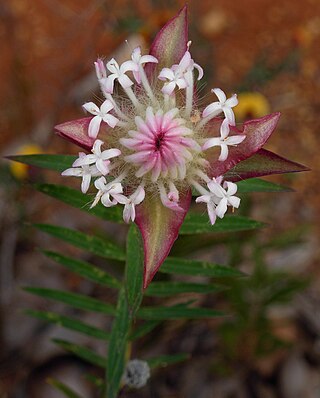
Pimelea spectabilis, or bunjong, is a species of flowering plant in the family Thymelaeaceae and is endemic to the south-west of Western Australia. It is an erect shrub with very narrowly elliptic leaves and heads of white, pale pink or pale yellow flowers surrounded by 4 or 6 egg-shaped involucral bracts.

Pimelea serpyllifolia, commonly known as thyme riceflower, is a species of flowering plant in the family Thymelaeaceae and is endemic to southern Australia. It is an erect shrub with narrowly elliptic to spatula-shaped leaves, and compact heads of 4 to 12 yellow, yellowish-green or white flowers surrounded by 2 or 4 leaf-like involucral bracts. Male and female flowers are borne on separate plants.

Pimelea ligustrina is a species of flowering plant in the family Thymelaeaceae, and is endemic to south-eastern Australia. It is a shrub with lance-shaped or narrowly elliptic leaves arranged in opposite pairs, and clusters of creamy-white, white or pinkish flowers usually surrounded by 4 or 8, greenish to reddish brown involucral bracts.
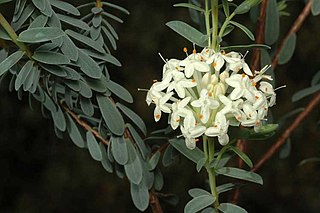
Pimelea ciliolaris is a species of flowering plant in the family Thymelaeaceae and is endemic to a restricted area of New South Wales. It is a stunted shrub with narrowly elliptic leaves and heads of densely hairy, cream-coloured to pale yellow flowers.

Pimelea glauca, commonly known as smooth riceflower, is a species of flowering plant in the family Thymelaeaceae and is endemic to eastern Australia. It has elliptic to more or less lance-shaped or linear leaves and creamy-white flowers arranged in heads of seven or more on the ends of the stems, with four lance-shaped to egg-shaped bracts at the base of the inflorescence.
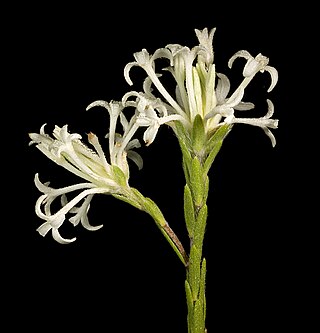
Pimelea longiflora is a species of flowering plant in the family Thymelaeaceae and is endemic to the southwest of Western Australia. It is an erect, spindly shrub with linear to narrowly elliptic leaves and erect clusters of white to cream-coloured flowers, surrounded by 4 to 6 green, egg-shaped involucral bracts.
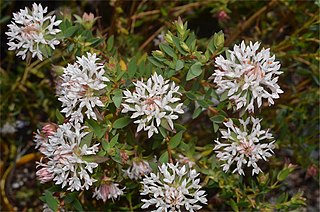
Pimelea sylvestris is a species of flowering plant in the family Thymelaeaceae and is endemic to the south-west of Western Australia. It is an erect shrub with narrowly elliptic to elliptic leaves arranged in opposite pairs, and compact heads of white or pink flowers surrounded by 2 or 4 pairs of narrowly egg-shaped involucral bracts.
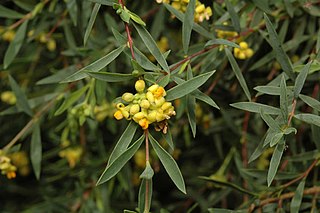
Pimelea neoanglica, commonly known as poison pimelea or scanty riceflower, is a species of flowering plant in the family Thymelaeaceae and is endemic to inland areas of eastern Australia. It is an erect, dioecious shrub with narrowly elliptic leaves and heads of greenish-yellow flowers.
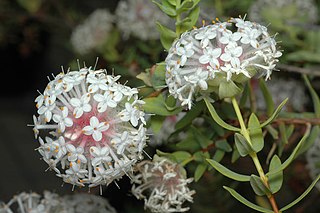
Pimelea avonensis is a species of flowering plant in the family Thymelaeaceae and is endemic to the south-west of Western Australia. It is a shrub with narrowly egg-shaped or elliptic leaves and clusters of white, tube-shaped flowers.

Pimelea cracens is a species of flowering plant in the family Thymelaeaceae and is endemic to the southwest of Western Australia. It is an erect, spindly shrub with narrowly elliptic to egg-shaped leaves and creamy green to pale yellow flowers surrounded by 6 or 8 yellowish or pale green and reddish involucral bracts.
Pimelea micrantha, commonly known as silky rice-flower is a species of flowering plant in the family Thymelaeaceae and is endemic to southern Australia. It is a much-branched undershrub with narrowly elliptic to lance-shaped leaves and compact clusters or heads of densely hairy, creamy white flowers.
Pimelea pendens is a species of flowering plant in the family Thymelaeaceae and is endemic to the southwest of Western Australia. It is an erect, spindly shrub with egg-shaped to narrowly elliptic leaves and compact, pendulous clusters of pale green flowers surrounded by 2 to 4 pairs of green or yellowish-green involucral bracts.
Pimelea penicillaris, commonly known as sandhill riceflower, is a species of flowering plant in the family Thymelaeaceae and is endemic to Central Australia. It is an erect, dioecious shrub with densely hairy young stems, densely hairy, pale silvery green, elliptic leaves, and compact heads of white to yellow or pink flowers surrounded by 6 to 12 silky-hairy, silvery or brownish involucral bracts.
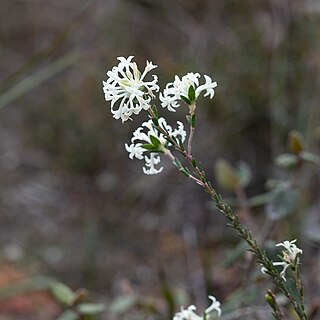
Pimelea phylicoides, commonly known as heath rice-flower, is a species of flowering plant in the family Thymelaeaceae and is endemic to southern continental Australia. It is an erect shrub with densely hairy young stems, narrowly egg-shaped to elliptic leaves, and heads of white flowers surrounded by 3 to 6 involucral bracts.
Pimelea subvillifera is a species of flowering plant in the family Thymelaeaceae and is native to the south-west of Western Australia and to South Australia. It is usually an erect shrub and has elliptic leaves and heads of white flowers surrounded by 8 to 18 narrowly egg-shaped involucral bracts.

Pimelea tinctoria is a species of flowering plant in the family Thymelaeaceae and is endemic to the south-west of Western Australia. It is an erect, spindly shrub with elliptic leaves arranged in opposite pairs, and compact heads of many yellow or yellowish-green flowers usually surrounded by 4 to 7 pairs of egg-shaped to narrowly elliptic yellow and green involucral bracts.
Pimelea villifera is a species of flowering plant in the family Thymelaeaceae and is endemic to the south-west of Western Australia. It is an erect, dense shrub usually with linear to narrowly elliptic leaves arranged in opposite pairs, and compact heads of many white flowers usually surrounded by 6 to 10 pairs of green and yellowish, narrowly egg-shaped involucral bracts.















